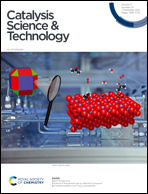Breaking the scaling relationship of ORR on carbon-based single-atom catalysts through building a local collaborative structure†
Abstract
The structure of M–N4, in which one metal atom is anchored by 4 N atoms, is the main active structure of N-doped carbon-based single-atom catalysts (SACs). However, we still lack efficient strategies for improving their activity. In this DFT study, M–N4 is doped with phosphorus or sulfur, which can be realized in many experiments by the addition of a P/S source. Previous studies simply attributed the improved activity of the metal site to the electronic effect of non-metal doping using the d-band center theory, which is inaccurate for understanding the ORR performance in the P/S-doped M–N4. We found that the strong interactions between P/S and O cause the doping site to be occupied by adsorbed O atoms, whose effects on the ORR process have been ignored for a long time. The local collaborative structure further stabilizes OOH*/OH* and weakens  on metal sites by hydrogen bond and repulsive interactions, for which the scaling relationship of ORR could be broken. In our P/S-doped models, the onset potentials of ORR in the 4e− mechanism on M1–N4 (M1 = Co, Ni, Cu, Rh, Ir, and Pt) and those in the 2e− mechanism on M2–N4 (M2 = Ni, Cu, Pd, Ag, Pt, and Au) has increased.
on metal sites by hydrogen bond and repulsive interactions, for which the scaling relationship of ORR could be broken. In our P/S-doped models, the onset potentials of ORR in the 4e− mechanism on M1–N4 (M1 = Co, Ni, Cu, Rh, Ir, and Pt) and those in the 2e− mechanism on M2–N4 (M2 = Ni, Cu, Pd, Ag, Pt, and Au) has increased.



 Please wait while we load your content...
Please wait while we load your content...